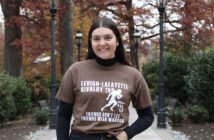It is a common belief that international students at Lehigh tend to make friends exclusively within their respective nationalities. However, a survey of 113 students debunks that idea and shows that foreign students are more likely to have American friends than not.
Approximately 18 percent of the student population in the 2013-2014 school year came from foreign countries, according to the Lehigh Office of International Students and Scholars website. That means there were 1,262 international students in a total student body of approximately 7,000.
Only 3 percent of survey participants said they had no American students in their friend group, as opposed to 27 percent of participants who said they had no international students in their friend group.
Of the small percentage that said they had no American friends, all were international students. Those who answered that they had no international student friends were all American. While two-thirds of survey participants said their friend group consisted of only American students, only a quarter of survey participants said their friend group consisted of a mix of international and American students.
Participants who identified themselves as international students more commonly answered that they had American friends, but American participants did not answer as frequently that they were friends with international students.
This could be influenced by the population size of foreign students, which, in comparison to the American student majority, is a much smaller and less probable group to encounter.
According to Stacy Burger, the assistant director of International Services, international students forming connections with American students is something the office heavily considers when organizing programs and communicating with students.
“(One) thing we tell our international students is that they should never assume that people are not interested in them, because even though we have a lot of Chinese students, it doesn’t mean you don’t have a unique story or experience,” said Jeanne Ma, assistant director of international students and scholars. “So we tell our Chinese students, especially, that you should make an effort to approach American students to introduce who you are because you are different from another Chinese student.”
Before coming to Lehigh, some international students participate in “Step Up,” a summer program for students who speak English as a second language. The program aims to give students the opportunity to improve and practice their English before classes begin. The ESL program also hosts “Let’s Talk,” where fluent English speakers come in to converse with non-fluent speakers who attend the event.
Although Lehigh provides these opportunities with their ESL program, many still attribute the divide between American and international students to language barriers.
“Language is the number one barrier,” Ma said. “Then culture.”
Yuchen Cai, ’17, an international student from China, said she remembers her first day at Lehigh when, at “Step Up” orientation, she could not understand any English.
Cai said her English education consisted mostly of writing and reading, but did not incorporate as much listening or speaking skills. Even though Cai participated in “Step Up,” she said she still made friends mostly with Chinese students because of the shared language.
“I think if (international students) are better at English, they are better at making friends with Americans,” Cai said.
Even though it is her second year, Cai says speaking English is still one of her major challenges, though she believes she has improved.
However, not all international students face the same challenges. Irene Villafañe, ’17, a student from Spain, has had almost an opposite experience. She said her friends are mostly American students, and she is a member of Alpha Chi Omega sorority.
Villafañe studied in a boarding school in the United States and said that during high school, she befriended many international students. In comparison, she has made more American friends at Lehigh.
“It was not hard for me (to make American friends) because I lived with a lot of Americans in my hall last year, but I feel like it depends on the person,” Villafañe said. “Some people are less social, and some people are more social.”
She said her major challenge in making these bonds was the difference in culture and the shock some people experience.
The International Services office is trying to do more to integrate international students into American culture and bridge the gap between these two groups.
According to Ma, International Services is trying to revamp an old mentorship program that had previously died out. The program would begin in the fall of 2015 for incoming international first-year students and would match them with an upperclassmen American student mentor. These mentors would contact their respective students throughout the summer before coming to Lehigh and then meet during international student orientation in August.
“I feel like maybe we should do more and see more change, but that’s why we’re starting the mentor (program) and why I think it would probably help,” Ma said.





Comment policy
Comments posted to The Brown and White website are reviewed by a moderator before being approved. Incendiary speech or harassing language, including comments targeted at individuals, may be deemed unacceptable and not published. Spam and other soliciting will also be declined.
The Brown and White also reserves the right to not publish entirely anonymous comments.
2 Comments
Was this an actual research study/experiment? If so, is there any way that I would be able to have a copy of the study? I would like to use it as a reference for my research project on international relationships/friendships.
Hi Alicia- Thank you for your interest! This article is a few years old, and I’m not sure if there is any current research available.